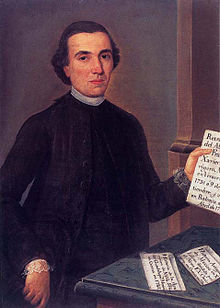User:Itsgravity/Antonio de Saavedra Guzmán




Antonio de Saavedra Guzmán (c. 1556, Mexico City-c. 1622[1]), aristocrat, civil servant, historian y new Spanish poet of the Spanish Golden Age. He wrote the epic poem El Peregrino Indiano, narrating the conquest of Mexico by the troops of Hernán Cortés, the first poetic work of American authorship edited and printed in history[2], also catalogued in Mexican Historiography by the Enlightenment scholar Francisco Javier Clavijero. During his study in the court of Madrid, he was connected with the main literary figures of his time, including Lope de Vega, who highlighted his courtly virtues and compared the relevance of his work to that of Pharsalia by the Roman poet Lucan[3]. In the viceroyalty of New Spain, he held the positions of corregidor of Zacatecas, alcalde mayor of the provinces of Michoacán, Pachuca and Cuautitlán, visitador to Texcoco, and others
Origins
[edit]Born in Mexico City around the year 1556,[4] second son of Juan de Saavedra Guzmán (brother of Alonso de Saavedra Guzmán, II encomendero of Tilantongo), and Regina de la Cadena y Sotomayor (sister of Melchor de la Cadena, provost of the Royal and Pontificial University of Mexico)[5]. His paternal grandfather was the Sevillian Luis de Guzmán Saavedra, I encomendero of Tilantongo and Ecatepec (son of the I condes de Castellar, therefore great-grandson of the Duke of Medina Sidonia and of the Duke of Feria), and his grandmother Marina de Estrada (daugher of Alonso de Estrada, governor and captain general of New Spain, presumed legitimate son of King Ferdinand II of Aragon).[6] His maternal grandfather was the prominent miner and Sevillian financier Antonio de la Cadena y Maluenda, alcalde mayor and alcalde ordinario of Mexico City, factor and treasurer of the Royal Treasury and proprietor of the mines of Taxco, Sultepec and Zumpango (brother of the bishop Luis de la Cadena, provost of the University of Alcalá), and his grandmother Francisca de Sotomayor, II encomendera of the Pachuca mines (only daughter of Pedro Díaz de Sotomayor, conquistador of Mexico and Oaxaca, councilor of the province of Pánuco and the encomendero of the Pachuca mines).[7]
Saavadra Guzmán married his second cousin, Catalina de Villafañe y Alvarado, the paternal granddaughter of the conquistador Ángel de Villafañe, governor and captain general of La Florida, and maternal granddaughter of the conquistador Jorge de Alvarado, the lieutenant governor and captain general of Guatemala (brother of Pedro de Alvarado, an adelantado), about whom he wrote many verses in El Peregrino Indiano:
Y pues fortuna la ocasión me ofrece,
para decir, Sabed que soy casado
con nieta del segundo, sin segundo,
que ganó con Cortés el nuevo mundo.
por Jorge de Alvarado el invencible
lo digo, que es de mi mujer abuelo,
cuyo valor, y fuerza es imposible
explicar, si no ayuda el alto cielo.
Hermano es de don Pedro, aquel temible
De quien temblaba el mexicano suelo.
Training and career
[edit]The life of Antonio de Saavedra Guzmán illustrates in a singular way the "cursus honorum" of the Creole nobility in the time of the early Spanish rule over the Americas. His family origins and fortunate economic station gave him the opportunity to receive a privileged education. In his youth, he was taught in classical Spanish literature,Latin, and Nahuatl, which he mastered with great skill.


[[Category:Mexican nobility]] [[Category:Poets]] [[Category:Spanish-language poets]] [[Category:Spanish Golden Age]] [[Category:Poets from Mexico City]] [[Category:16th-century Spanish poets]] [[Category:16th-century Spanish historians]] [[Category:Mexican historians]]
- ^ "MEXICO,259,N.224 - Inventario de bienes: Saavedra Guzmán, Antonio de". PARES. Retrieved 2021-01-25.
- ^ "Antonio Saavedra y Guzmán | Real Academia de la Historia". dbe.rah.es (in Spanish). Retrieved 2021-01-25.
- ^ "El peregrino indiano, de Antonio de Saavedra Guzmán | Proyecto Estudios Indianos". estudiosindianos.org. Retrieved 2021-01-25.
- ^ "Catálogo de protocolos del Archivo General de Notarías de la ciudad de México - FONDO SIGLO XVI - Ficha de contenido". cpagncmxvi.historicas.unam.mx. Retrieved 2022-05-30.
- ^ "Porras Muñoz, Guillermo. "La Calle de la Cadena en México". UNAM-Universidad Nacional Autónoma de México. Instituto de Investigaciones Históricas" (PDF).
- ^ "Alonso de Estrada | Real Academia de la Historia". dbe.rah.es. Retrieved 2021-01-26.
- ^ "PATRONATO,67,R.2 - Méritos:Jorge y Pedro de Alvarado,otros: Nueva España". PARES. Retrieved 2022-05-30.
